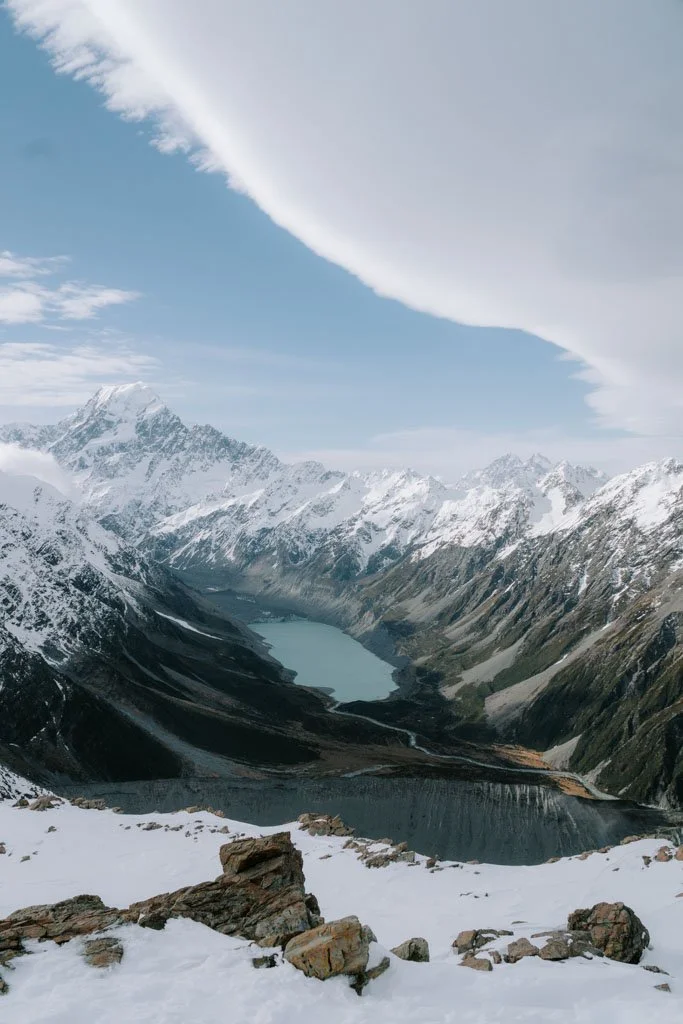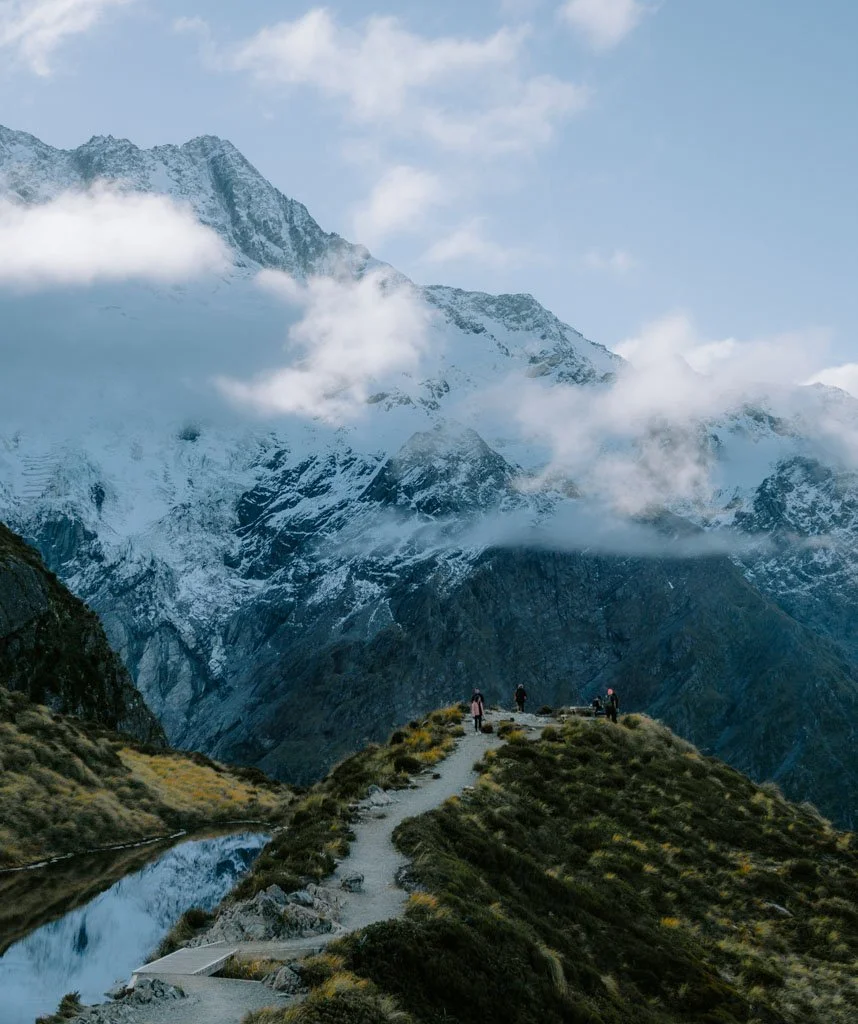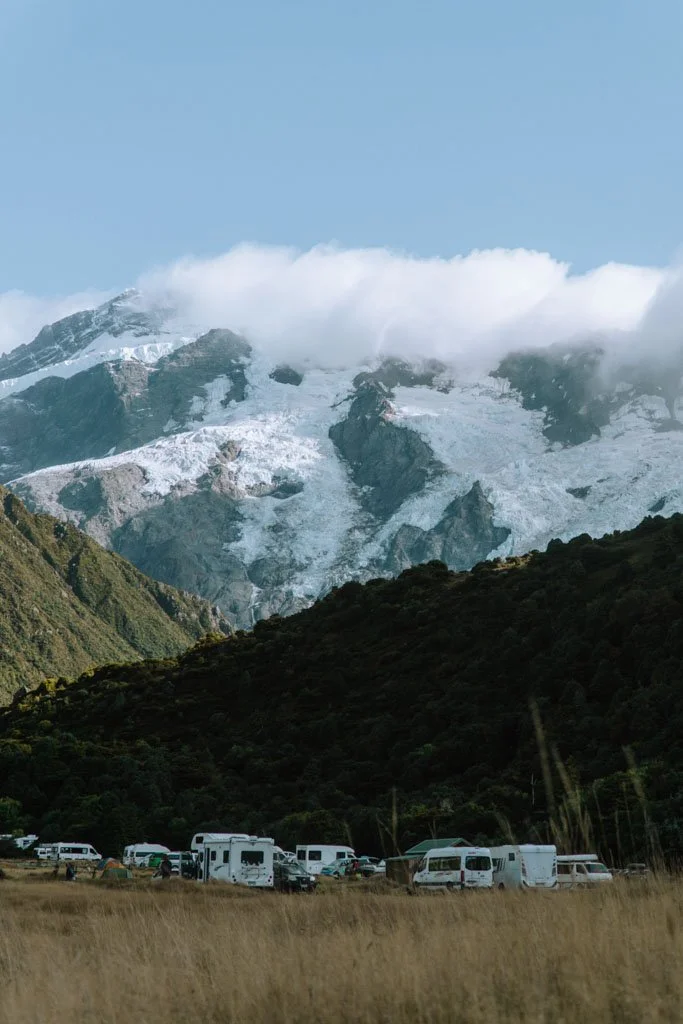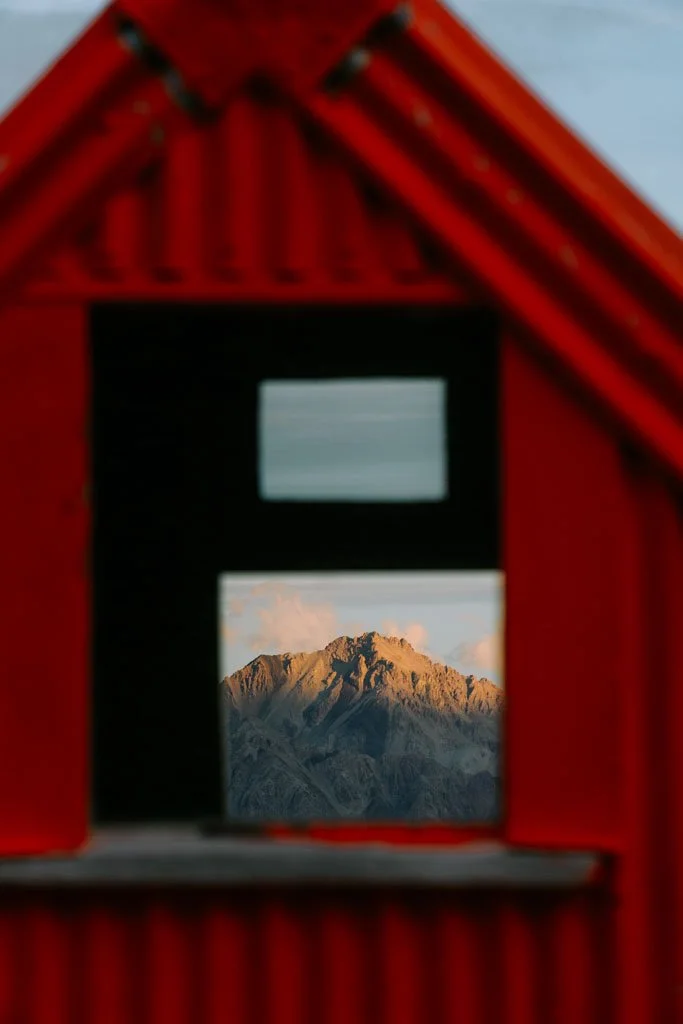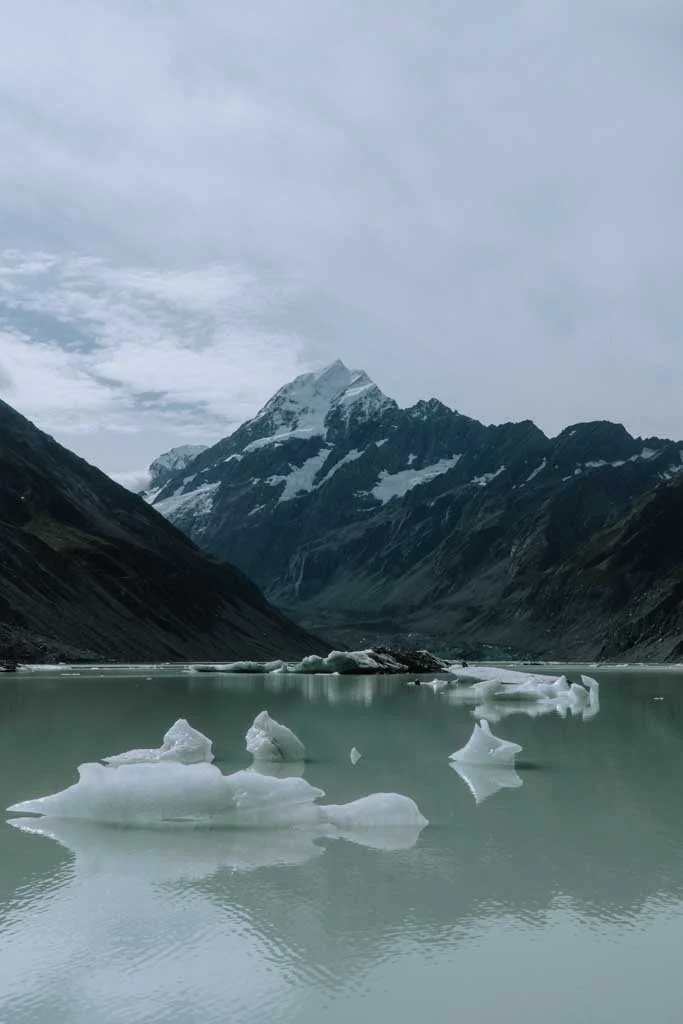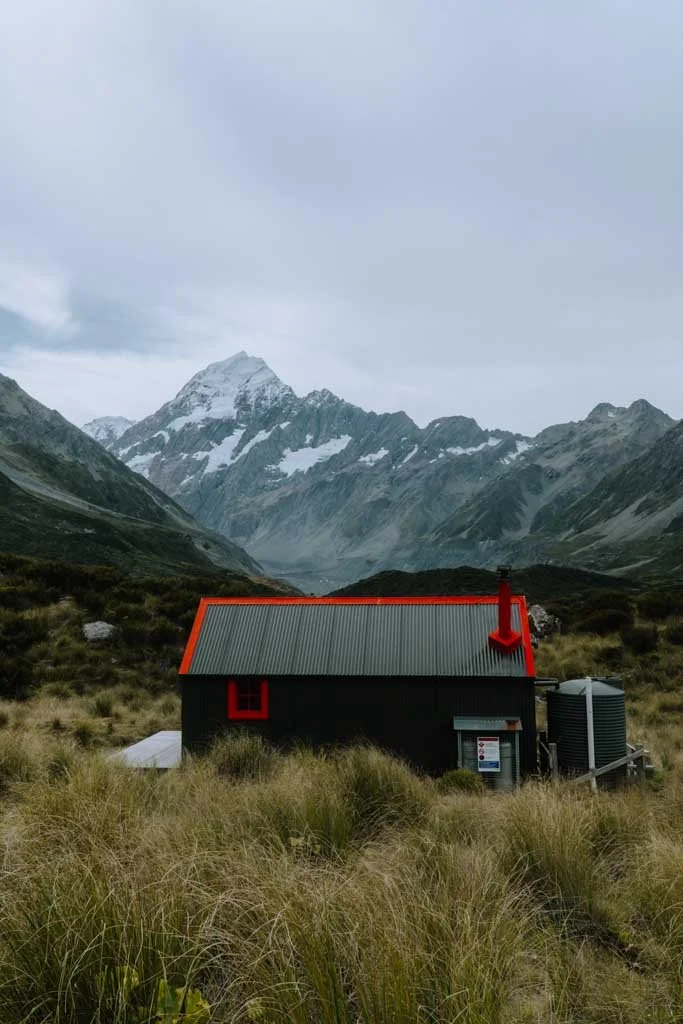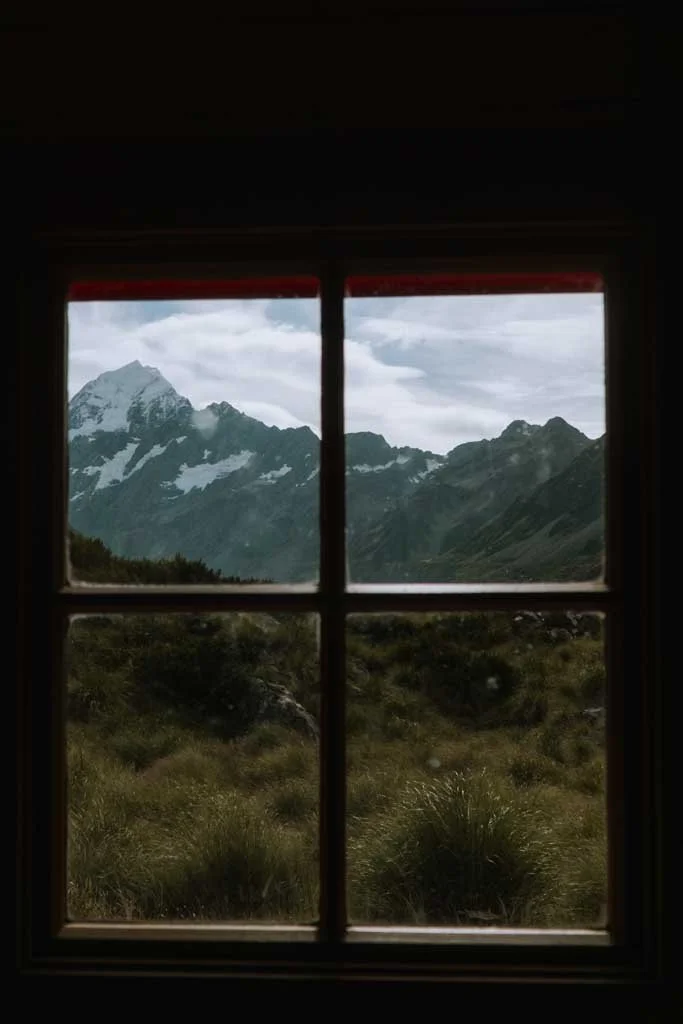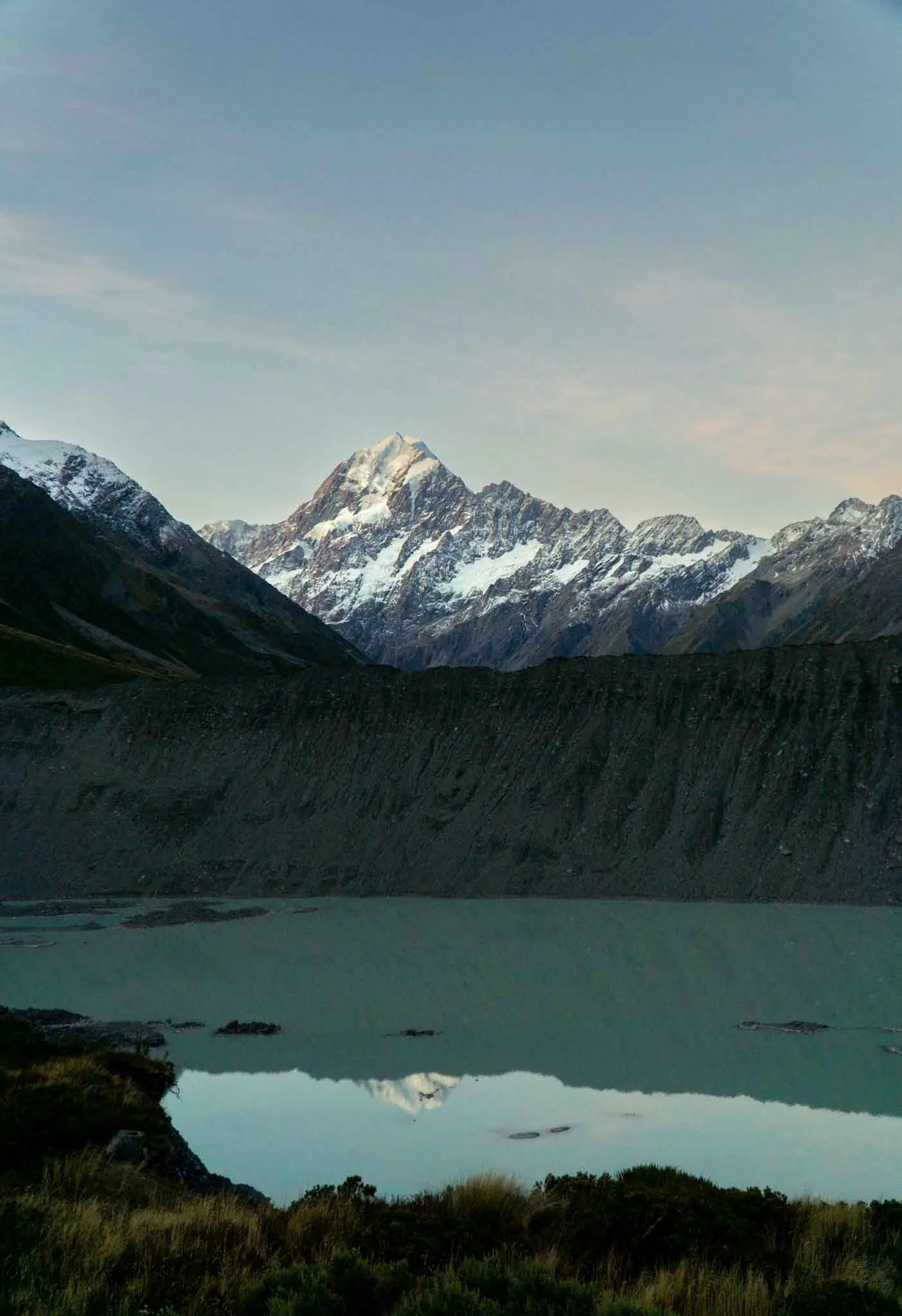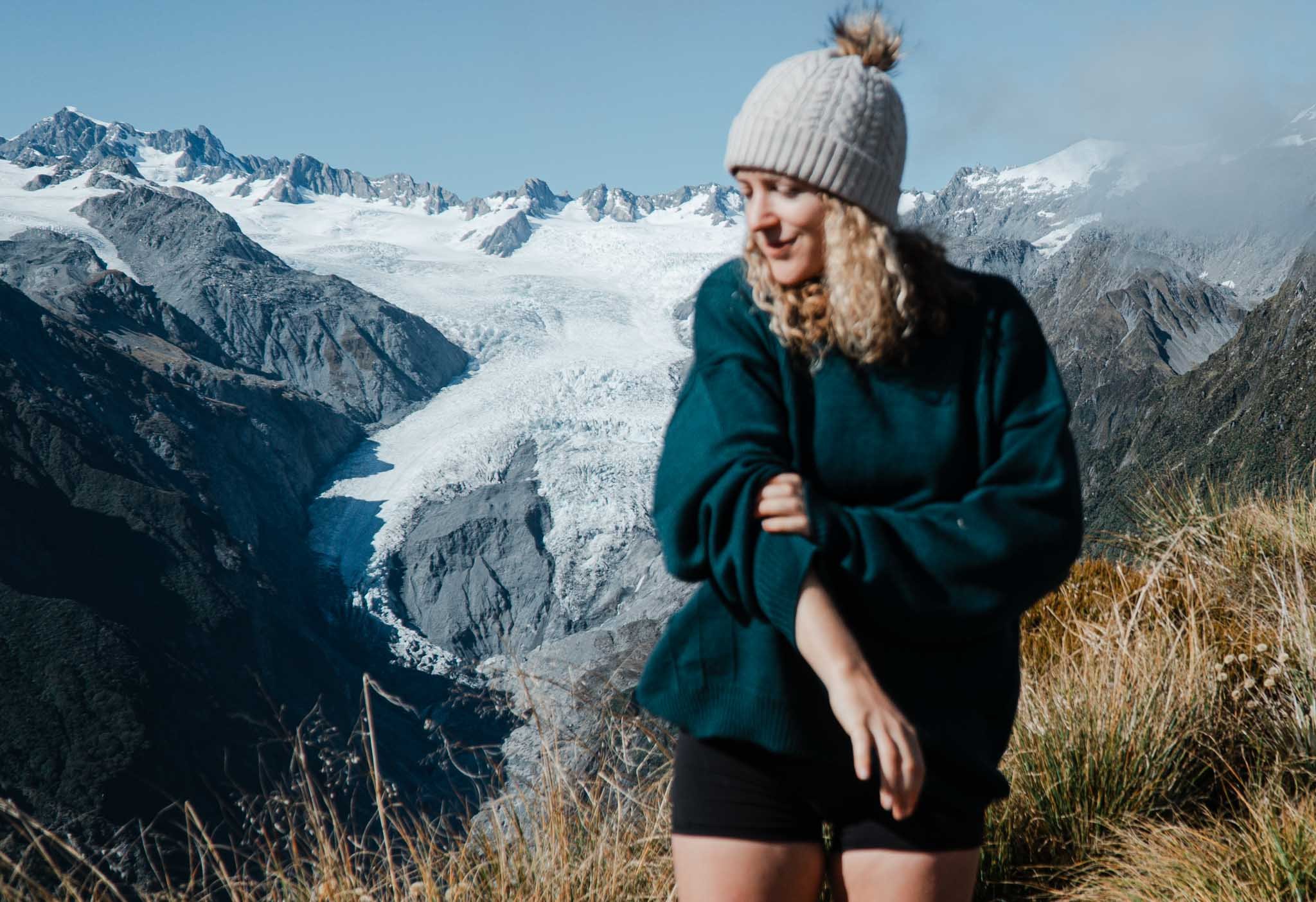What to do in Aoraki/Mount Cook National Park, home to glaciers, grandeur & high mountain peaks
From hiking to see the Tasman glacier to getting a glimpse of New Zealand’s tallest mountain peak, here are the best things to do in this epic national park.
Disclosure: This article contains affiliate links, so I may make a commission at no extra cost to you if you book through those links. Thanks for your support.
Everywhere in New Zealand is beautiful to me. But, if you press me, I will admit it. I think Aoraki/Mount Cook is the singularly most beautiful part of New Zealand.
There’s something about the mountains, rising straight up from the valley floors, rocky peaks strung with glaciers and banks of cloud. Stand still and listen and you’ll hear the sound of rock and ice falls high in the mountain tops, the boom cracks ricocheting off the valley walls.
I’ve lost count of how many times I’ve been to Aoraki/Mount Cook now — each time I climb a little higher, and a little further. I’ve seen the mountains there under winter snow, in late summer sunshine, and cloaked in clouds and rain.
I have yet to lose the sense of wonder I feel every time I set my course on that one narrow road leading into Mount Cook.
The park is beauty on a grand scale.
Aoraki/Mount Cook, as seen from Mueller Hut
Mt Cook — Aoraki in Māori — is the tallest mountain peak in New Zealand. This rocky spire 3,724 metres above sea level is where Sir Edmund Hillary famously honed his climbing skills before taking on Everest.
Mount Cook isn’t the only drawcard in Aoraki/Mount Cook National Park; there are 19 peaks soaring over 3,000 metres and 178 glaciers covering more than a third of the park.
The Sealy Tarns track
Despite the hostile-sounding nature of the park, there are excellent short walks in the park that almost anyone can do.
This accessibility is great, but it also means that visiting Aoraki/Mount Cook comes with a big caveat.
It’s busy.
Very, very busy (by New Zealand standards anyway — it’s worth noting that we think a handful of cars is a traffic jam. More than 20 people on a beach at one time is ‘Europe level busy’ for us. So, you might not find it crowded, but I definitely do).
Staying overnight in the national park is a good way to cope with the crowds, because you can be on the trails either late or early. The only catch is that accommodation is hard to come by in the park — you’ll need to book far in advance for the summer season.
South Island itineraries that pass by Aoraki/Mount Cook
Located roughly halfway between Christchurch and Queenstown — around four hours driving from each — Aoraki/Mount Cook is a popular stop on any South Island road trip.
The amount of time you should spend in the park really hinges on whether you can find accommodation. If rooms are available, staying one or two nights is ideal.
If there are no rooms left, you may have to stay around Lake Tekapo or Twizel, in which a case a day trip is your best option.
Where to stay in Aoraki/Mount Cook
The White Horse Hill campground in Aoraki/Mount Cook
There are limited accommodation options in the park — several hotels, a backpackers, and a campground. Room space is limited and this is one of the most popular places in New Zealand, so you’ll need to book ahead.
Book as far in advance as you can — check availability on Booking.com now.
If availability is down to the dorm rooms in the Haka House hostel in Mount Cook, it’s still a decent option. It’s a nice spot as far as hostels go (I loved it!), and having kitchen facilities is useful (the only restaurant in the park is an expensive option at The Hermitage).
If there are no rooms available, the White Horse Hill campground is a great choice for anyone in a campervan.
FEATURED STAY
Aoraki Alpine Lodge
A basic but very serviceable place to stay, with a great shared kitchen and lounge area. With almost nowhere to eat in the park, having cooking facilities was perfect.
Hiking in Aoraki/Mount Cook National Park
Up at Sefton Bivvy
The main things to in Aoraki/Mount Cook are hikes — this is where you’ll find some of the best short walks in New Zealand.
You don’t need to be a seasoned hiker, or even be extremely fit to enjoy the walks in Aoraki.
Trails range from 30 minutes to a full day.
You’ll need to pack your own water and snacks, and ideally lunch as there are only a couple of places to get food in Mount Cook Village (stop in Twizel for supplies on the way through). Make sure you take a hat and sunscreen as well, as the trails are mostly exposed to the sun.
It’s also a good idea to have warm and windproof layers, especially if you plan on hiking to higher elevations (like Sealy Tarns). For most of the trails, though, you’ll be able to walk in sneakers or trail running shoes.
Hike the Hooker Valley Track — the best activity in the national park (3 hour return walk)
Most people come to Aoraki/Mount Cook for the Hooker Valley Track. This walk is possibly one of the best short walks in New Zealand.
It’s only three hours return and the track is accessible to people of all levels of fitness and experience. It feels very special being able to see glacial and mountain scenery on such an accessible walk.
The trail is very clearly marked and evenly graded the whole way. Lots of families with children make the trek.
The walk takes you through a valley to the Hooker Lake, where you can see icebergs crumbling from the Hooker glacier, and the peak of Aoraki/Mount Cook rising behind the glacier.
The track is popular, so you can expect to be walking in a line of people most of the way.
My best tip for you on this hike is to see if you can find the turn off for Hooker Hut. If you can spot it (and it’s not easy) you’ll be able to duck away from the crowds, and enjoy peace and quiet at the little red-accented hut with perfect views of Aoraki/Mount Cook.
Climb the ‘stairway to heaven’ to see the Sealy Tarns (3-4 hour return walk)
Another epic hike in Aoraki/Mount Cook National Park is the Sealy Tarns track.
A tarn is a small mountain lake which often form in glacial landscapes.
Climbing up to the Sealy Tarns involves 2,200 steps, which people call the ‘stairway to heaven.’
The stairs leading up to the tarns
It sounds more intimidating than it is, although steep the track is in good condition and has great views of the Hooker valley and Aoraki/Mount Cook. Take your time and in no time at all you’ll find yourself looking at the freshwater tarns.
In summer, alpine flowers add an extra element of beauty.
Hike to Mueller Hut
Mueller Hut is famous for being built and opened by Sir Edmund Hillary. From it’s rocky mountain perch, it beckons to hikers and climbers who want to spend a night in a superb alpine environment.
The hut is located two hours beyond the Sealy Tarns.
It’s a four hour hike in total to reach the hut from the Aoraki/Mount Cook Visitor Centre, so if the hut is booked, and it often is, you can hike up and back as a tough but rewarding day hike.
Despite its popularity, this is still an alpine hike in difficult terrain.
In the summer months — December to February — you can hike the Mueller Hut route with moderate experience.
Outside of this time you might need mountaineering experience with crampons and ice axes.
Ask at the Aoraki/Mount Cook Visitor Centre for guidance on conditions, and don’t overestimate your abilities.
It’s free to enter the visitor centre and well worth visiting to learn more about the national park and the trails you can find there.
Hike to Kea Point (go at sunset for incredible colours)
1 hour return from White Horse Hill Campground
The Kea Point track is a gorgeous easy walk you can do from the campground.
At the lookout point, you can see the peak of Aoraki/Mount Cook reflected in a glacial lake below.
I went around sunset and when I rounded the last corner the tip of the mountain was bathed in a warm red glow.
It was stunning, so if you’re camping I recommend checking the sunset times and going about 30 minutes before it’s due to set.
The path back to the camp is well marked and easy to follow, so as long as you have a torch you won’t get lost on the way back.
Hike to the Tasman Lake Viewpoint
The Tasman glacier is New Zealand’s longest glacier.
An impressive 23 kilometres of ice cascade out of the mountains and into the Tasman Lake.
You can walk to a view point for the Tasman glacier in one hour, so it’s a nice short hike.
From the viewpoint, you can see the stubby end of the glacier, which often looks quite dirty. It’s not the most visually impressive glacier you can see in New Zealand, at least not from this vantage point (it’s a different story if you take a helicopter up to the glacier) but it’s still cool to lay eyes on it.
The lake is a muddy, light brown colour, not quite the bright blue of Lake Pukaki, but sometimes ice bergs float in the lake.
There is also a second track which branches off the Tasman Lake Viewpoint walk and leads to the Blue Lakes, another pretty spot to admire the glacier and surrounding mountains.
I found the Blue Lakes pretty underwhelming though, so you could easily skip these and you won’t miss much.
Explore the glaciers in Aoraki Mount Cook National Park
Take a glacial boat tour
Glacial Explorers is the only glacier boat tour in New Zealand.
The cruise takes you around the Tasman glacial lake, weaving in and out of ice bergs as you get to see the Tasman glacier from the water.
The trip takes 2.5 hours, with around 1 hour on the lake. It’s a cool way of seeing the Tasman glacier, and because the ice is constantly changing, no two days are the same.
To go on the tour, you need to be comfortable walking the 1.5km to and from the lake edge (around 25 minutes walking each way).
Go on a Tasman glacier heli hike
If a heli hike is within your budget, walking on the Tasman glacier might be the very best thing to do in Aoraki/Mount Cook National Park.
Standing on a glacier is a surreal experience, one that brought a friend of mine to tears.
There are a couple of different heli hike tour operators, but they are priced around the same $700 per adult for a glacier landing and two hour hike.
Thanks for reading this far! I hope I’ve convinced you to visit Aoraki Mount Cook National Park — it’s truly a highlight of any New Zealand trip.
If you’re planning on road tripping around the South Island, you might also find these articles useful:
Check out incredible wineries near Queenstown
AUTHOR BIO
I’m a freelance travel writer from New Zealand with bylines in National Geographic Travel, Conde Nast Traveler, Travel + Leisure and more.
I’ve travelled up and down beautiful Aotearoa and I love sharing my recommendations for the best places to visit in New Zealand.
